Keratin treatments first became available in the early 2000s, and while they’re still around some twenty years later, they’re old technology in the hair world.
There have been many improvements to this class of hair treatments. Some use keratin, others make use of other proteins. Some are straightening and some are just smoothing.
Almost all use formaldehyde or formaldehyde-releasing chemicals, which are powerful hair straighteners that help keratin and other proteins bond to the hair. So there are various pros and cons of the new keratin treatments. We’ll help you find one that’s right for your hair.
Permanent Hair Straightening with Keratin
These permanent hair straightening treatments are perfect for those with uncontrollable frizz or for people who coils and curls and want to change into silky straight tresses.
1. Japanese Permanent Hair Straightening
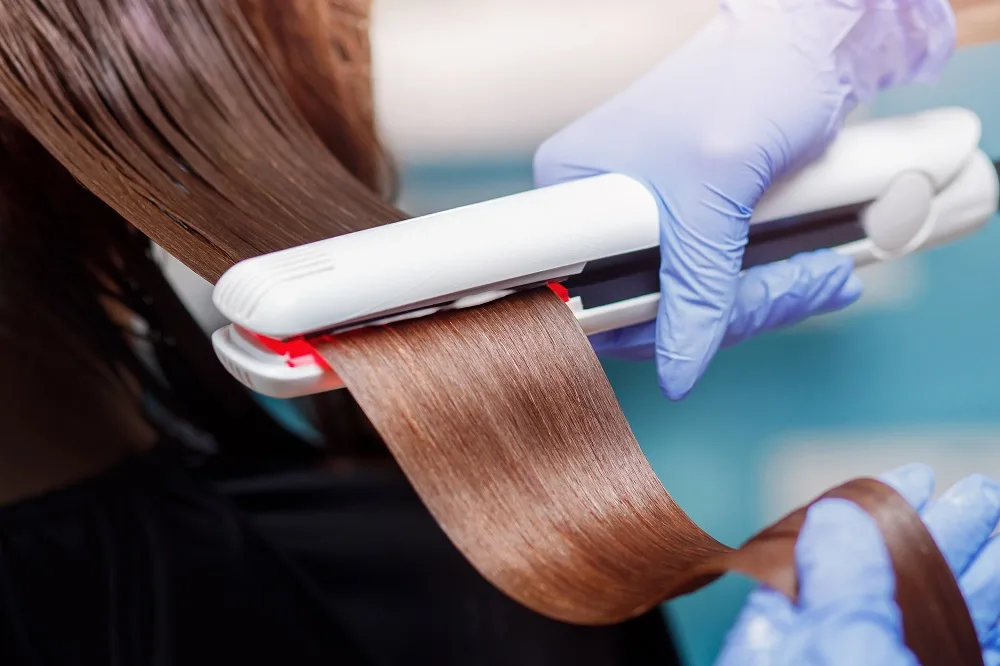
Also known as thermal reconditioning, Japanese hair straightening uses a solution that contains ammonium thioglycolate and is similar in composition to a perm. This breaks the protein bonds in the hair, transforming them from wavy to pin-straight.
Then a flat iron is used to lock in the treatment and make it even straighter. There are varying products that use thermal reconditioning. Ask your stylist for the treatment.
Pros of Japanese Hair Straightening
This treatment works best on wavy or straight hair that’s chronically frizzy. The Japanese hair straightening solution breaks the protein bonds in the hair, allowing them to be reformed so that each strand lies smooth. Then a flat iron locks in the treatment and permanently removes frizz.
Cons of Japanese Hair Straightening
It contains no keratin, so it doesn’t have conditioning properties. Being permanent, you will see a demarcation line between your natural texture and the Japanese straightening as your hair grows out.
The waiting time between one treatment and the next is eight to 10 months. During this time, curlier textured hair can break off, so this treatment is better for those with wavy hair.
Japanese hair straightening contains no keratin but uses a keratin treatment heat process.
2. Keratin Hair Rebonding
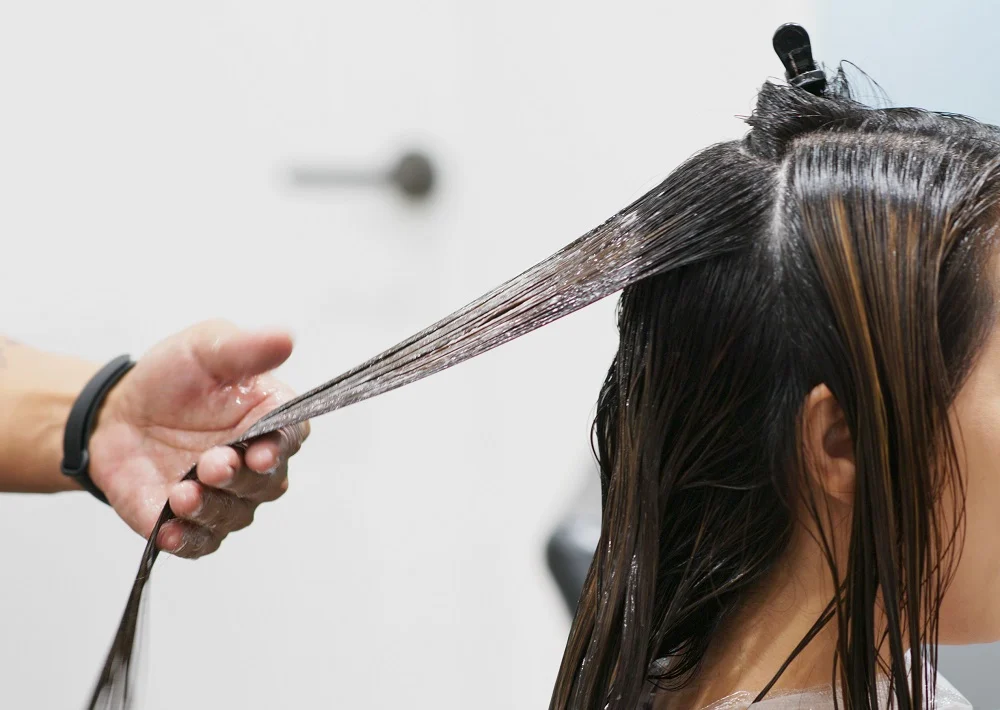
This treatment is similar to Japanese hair straightening in that it uses a relaxer first to straighten the hair.
But after rinsing the relaxer cream, it also uses a keratin solution to bond the protein to your hair to get it straighter than the relaxer cream could. Ask your stylist for the treatment.
Pros of Hair Rebonding
This treatment is great for getting a very straight look for those who have curly hair and want straight locks permanently. Relaxers get the hair straight, but it still takes blow drying every time to produce movement.
The additional keratin treatment in hair rebonding helps produce body in the hair, after which you won’t even need to blow dry your hair to get it straight and full of body on a regular basis.
Cons of Hair Rebonding
This treatment uses two harsh chemicals. Those found in the relaxer could be either sodium hydroxide (lye), ammonium thioglycolate, or sodium thioglycolate, which all break the hair’s curly protein bonds so that they become straight.
The keratin solution also contains formaldehyde or a formaldehyde releaser to straighten the hair further and allow the keratin to bond. Not everyone’s hair can process well under hair rebonding without becoming damaged.
Hair rebonding uses the same chemicals you’d find in a perm plus keratin.
Traditional Keratin Treatments – Last Up to Six Months
A standard keratin treatment will coat the hair with keratin, filling in areas of the hair cuticle that are missing this vital protein. Keratin treatments can turn curly and frizzy hair into straight, glossy locks.
3. Brazilian Blowout for Kinks and Curls
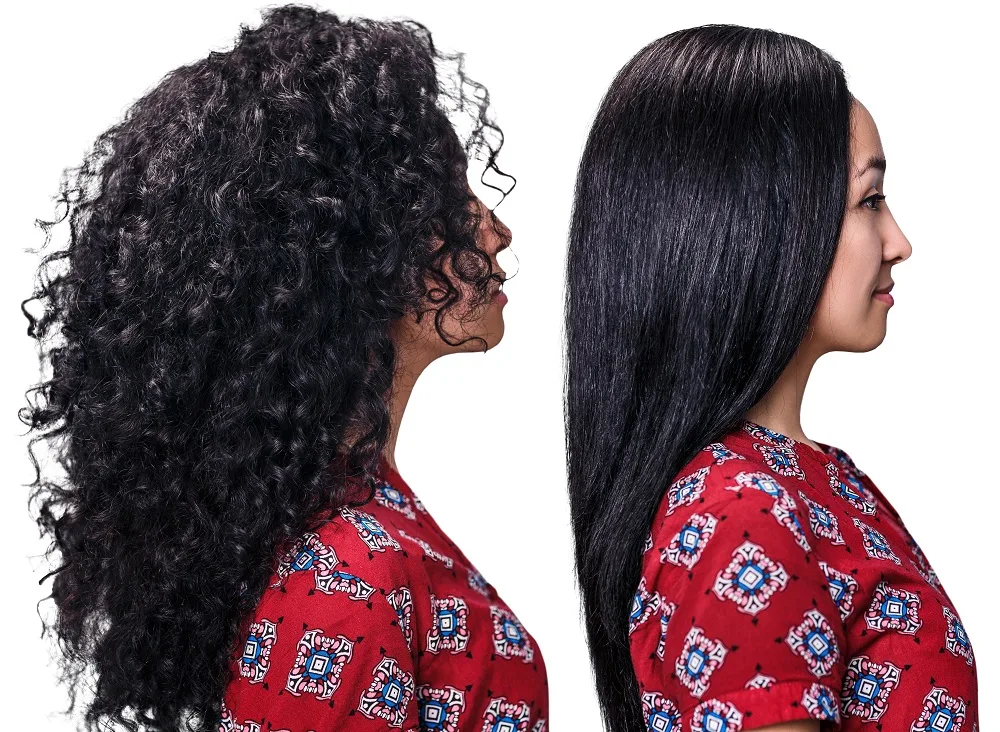
The Brazilian Blowout is a modified keratin treatment. It uses much the same chemicals and heat processing, but it isn’t quite as strong. It leaves the hair with some waves instead of turning bone straight. There are many products with this name. Ask your stylist for the treatment.
Pros of the Brazilian Blowout
There are several pros to the Brazilian Blowout:
- You can use heat tools like curling irons and flat irons right after getting a Brazilian Blowout.
- You don’t have to wait to wash it or style it as you like.
- It looks glossy and smooth.
- It’s a great treatment for those who have kinks and curls and want to achieve a straight look for a longer time than a regular blowout.
- It’s a buildable treatment, meaning successive Brazilian Blowouts will use fewer chemicals to get the same results.
Recommended: Brazilian Blowout Vs Keratin Treatment
Cons of the Brazilian Blowout
Brazilian Blowouts use formaldehyde-releasers and keratin. The hair bonds are broken with this treatment because of the excessive heat that’s used.
This is commonly referred to as “training” the hair when heat is used over time to break the protein bonds and make the hair easier to straighten. For this reason, your hair might not bounce back completely to its original texture.
Brazilian blowouts are great for curly hair, but your hair might not revert to its original texture.
4. Goldwell Kerasilk Control Intensive Smoothing Mask
Goldwell Kerasilk works well to reduce frizz and smooth all hair textures. It’s customizable, meaning the mix can be made stronger to straighten curls or weaker.
Pros of Goldwell Kerasilk
If you want to straighten your curls or just to tame frizzy hair, Goldwell Kerasilk Control can be customized to your preferred level of smoothing. It works well on hair that’s difficult to manage and leaves all hair types silky and smooth with reduced frizz. This treatment helps the hair to blow-dry quickly and hold its style. The process only takes two hours and you can wet it or style it immediately afterward.
Cons of Goldwell Kerasilk
Goldwell recommends that you use their line of smoothing products after the treatment to help maintain the treatment for longer. It claims to be completely formaldehyde-free, but because it lasts up to six months, it must use a formaldehyde releaser.
5. GK Hair Smoothing Keratin Treatment
This is a salon-level treatment for at-home use.
Pros of GK Hair Smoothing
GK Hair Smoothing is great for curly or coarse textures that don’t straighten well on their own. Bonus! It is a relatively cheap treatment as the cost for it is less than $200.
The cost of a keratin treatment in a salon can go up to $500. You can do the same procedure at home with this keratin treatment
Cons of GK Hair Smoothing
It contains methylene glycol, a formaldehyde releaser. You might not be able to reach each section of your hair to blow dry or flat iron it as required, so having someone to aid you in this might help.
For an at-home keratin treatment, you will probably need someone to help you flat iron in small sections.
Customizable Keratin-Like Treatments – Last Two to Four Months
These are salon treatments that last for less time than a standard keratin treatment. They smooth away frizz instead of straightening.
They contain fewer harsh chemicals, so they don’t have a very strong smell. For some of these, salon professionals don’t need to use gloves to apply them.
6. Trissola Solo Anti-Aging Hair Taming Treatment
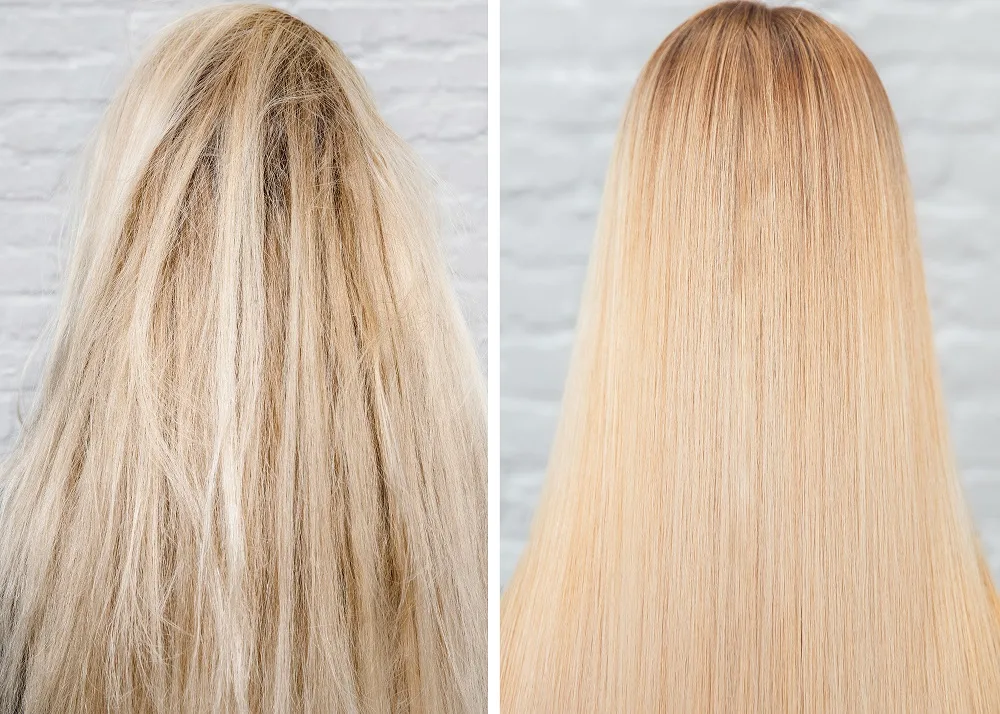
Trissola uses synthetic peptides that they claim have “Botox-like activity” to plump the hair and make it manageable. As hair ages and goes gray, it tends to become rougher and less compliant.
Pros of Trissola Solo
This is a very popular salon treatment that’s mild, so salon professionals don’t need to use gloves to apply it. Trissola uses synthetic peptides that they claim have “Botox-like activity” to plump the hair and make it manageable.
It removes frizz and improves elasticity to help reverse hair aging while keeping your natural curl and volume.
Cons of Trissola Solo
You have to use Trissola products for the taming treatment to last, which is an added expense. There is no ingredient listing readily available to verify their claims about there not being formaldehyde derivatives in their products.
7. Supersilk Smoothing System Tames All Frizz
Supersilk uses an amino acid formula to coat the hair, which is more durable than keratin. So, like other keratin treatments, it seals the hair cuticle to protect the hair from damage and add shine.
Pros of Supersilk Smoothing
It’s s specifically formulated to de-volumize and straighten curly hair and reduce frizz. It uses an amino acid formula to coat the hair, which is more durable than keratin.
The amino acids make it a strong formula that effectively keeps the hair protected from humidity and stops curly hair from reverting quickly under the pressure of workouts.
Cons of Supersilk Smoothing
This treatment uses glyoxylic acid as one of the main active ingredients to break the protein bonds in the hair. Glyoxylic acid is also a formaldehyde-release when used with heat. Supersilk maintenance products are recommended.
Glyoxylic is one of the new formaldehyde releasers used in keratin treatments. It’s a powerful straightener that helps the keratin bond.
8. Cezanne Keratin Treatment is for All Hair Types
Cezanne is another salon-customizable treatment. They use a heavy list of botanical ingredients to nourish the hair.
Pros of Cezanne Treatment
Cezanne Classic Treatment has many benefits:
- Cezanne salon artists customize the treatment to handle frizz only in its weakest form or to convert coils and kinds to straight tresses.
- It’s a buildable treatment, so it has the potential to create tresses that are silkier with each treatment.
- Cezanne contains a heavy list of botanical ingredients to nourish the hair.
- It contains fewer harsh chemicals, as compared to other keratin treatments, so it doesn’t have a very strong smell.
Cons of Cezanne Treatment
There is some speculation about whether Cezanne is a regular keratin treatment, with all the good and bad that goes with them. It is. Cezanne contains keratin and a formaldehyde-releaser to activate it, in this case, glyoxyloyl carbocysteine.
At-Home Keratin Maintenance Products
There are various shampoos, conditioners and oils that are meant to either aid the upkeep of a keratin treatment or deposit keratin slowly onto the hair, providing frizz-fighting and smoothing. These are the least damaging forms of keratin treatments because they require little or no heat to set them.
The formaldehyde-releasing chemicals are also used in low percentages. We know this because the keratin doesn’t bond to the hair for as long a period, so effects last for days or weeks instead of months.
9. Nume Tourmaline Hair Smoothing Treatment
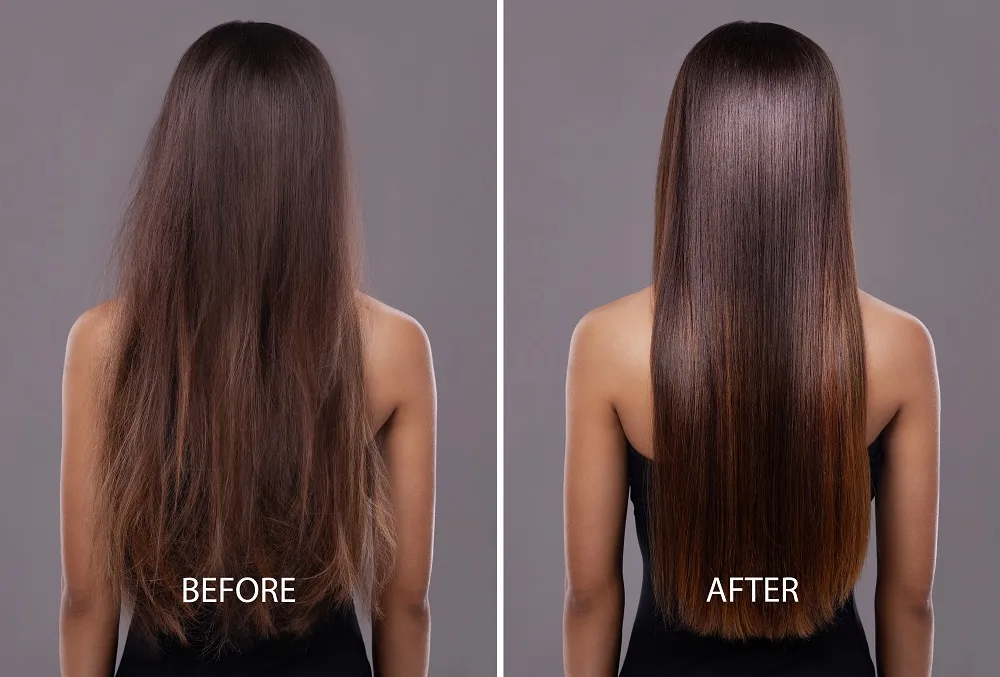
This is a highly conditioning treatment that lasts for three weeks and plumps the hair using different oils and glyoxylic acid, a formaldehyde-releaser and powerful hair conditioner. It makes hair smooth after the treatment. There is no damage noted with this treatment.
Pros of Nume Tourmaline Hair Smoothing
Nume uses powerful hair conditioners. It also loosens the protein bonds so that they can be reformed with heat. Yet it doesn’t “train” the hair with multiple passes of high heat.
A flat iron is required, but it is used at normal temperatures after drying the hair. The tourmaline helps make the hair smooth when flat ironing. It works great to straighten coily and curly hair textures.
Cons of Nume Tourmaline Hair Smoothing
Other than the fact that it contains a formaldehyde releaser, it’s a great product. It’s used infrequently enough to allow the product to fade naturally from the hair without buildup. It is recommended to repeat it every three weeks.
10. Keratin Complex Infusion Keratin Replenisher Cream
This is a blow-dry cream that contains keratin.
Pros of Keratin Complex Infusion Keratin Replenisher
This product extends the life of regular keratin treatments. It is good for temporarily fighting frizz and smoothing the hair, but not for making it ultra-straight.
It can be used with a diffuser for curly hair. It is used like a heat-protecting serum before blow-drying in a normal fashion and is very easy to use.
Cons of Keratin Complex Infusion Keratin Replenisher
Using this product more than once before shampooing can cause heavy buildup. It bonds to the hair with heat, which means that when you do shampoo, it might be difficult to wash out. It can also dry for some users, and the texture is not ideal.
It is good for fighting frizz temporarily and smoothing the hair, not straightening.
With maintenance treatments, the keratin doesn’t bond to the hair for as long a period.
11. Tresemme 7-Day Keratin Smooth Treatment
Tresemme created a treatment, a mini keratin treatment that can be used at home. Because it doesn’t last long, we’ll consider it as a maintenance treatment.
Pros of Tresemme 7-Day Keratin Smooth
Milder than a regular keratin treatment.
Cons of Tresemme 7-Day Keratin Smooth
The formula is not rinsed out but blow-dried into the hair and then flat-ironed. The amount of work is very similar to a regular keratin treatment, but this treatment only lasts seven days.
Is a Keratin Treatment for You?
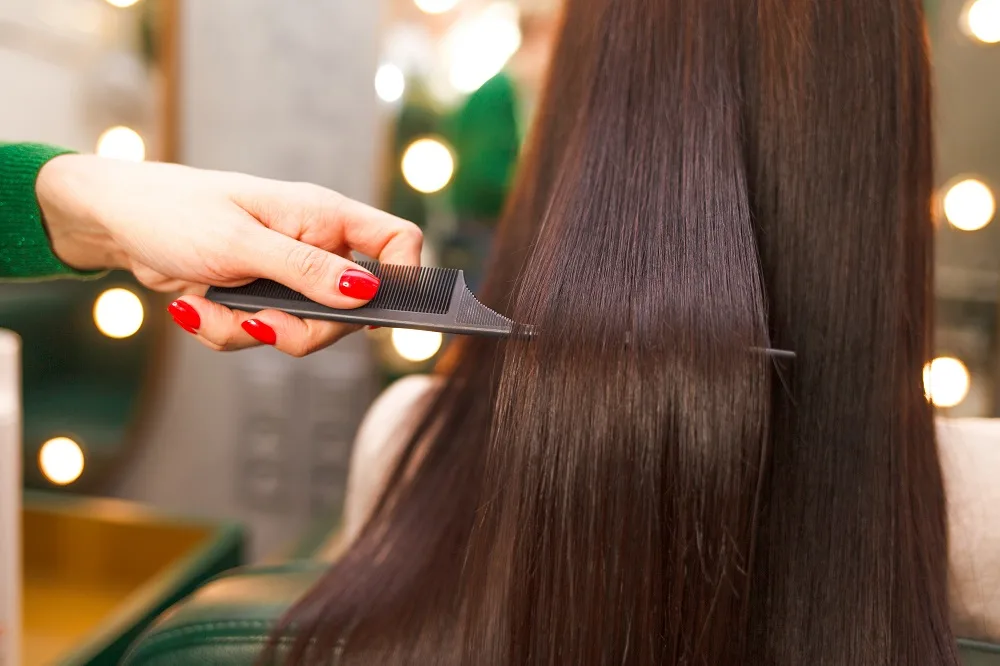
Keratin and keratin-like treatments each use a lot of heat in addition to chemicals. So if your hair is damaged, or fine, it might not be able to withstand the heat and chemical processing and break off.
Also, the more heat that’s used, the less likely the hair will bounce back to its original texture.
So if you get a keratin treatment, you will probably need to continue with them or transition out of them, as if they were a permanent treatment. Those with fine hair also have to be careful of coating their hair with anything, as it could snap.
Keratin provides a shell over the hair, so it might not be suitable for those with fine hair.
Formaldehyde Dangers of Keratin Treatments
When heat is used over the keratin treatment, it stretches the keratin into a straight form and helps it bond with the hair like a thin shell. But heat also releases formaldehyde in keratin treatments. Formaldehyde is carcinogenic when its fumes are inhaled.
Formaldehyde and formaldehyde-releasers can also be major irritants to the skin and scalp and can cause hair loss. A patch test should always be done first to make sure you’re not sensitive to the ingredients.
FAQs
No. Keratin treatment must contain formaldehyde to give you frizz-free, shiny smooth hair.
The kind that doesn’t use high heat and allows your hair to revert to its natural state within weeks. We like Nume Tourmaline Hair Smoothing for this.
They all contain at least one formaldehyde releaser. It can be tricky to spot them because new ones are constantly introduced.
If not, they contain a formaldehyde releaser.
No, but formaldehyde can if you are sensitive to it.
Perhaps the stylist didn’t use high enough heat to lock in the treatment.
Yes, some are maintenance treatments; some last only a few weeks, some a few months, and some six months or more.
If the heat is too much for your hair, it can be damaging, and you can get too many.
Keratin hair treatments use formaldehyde or formaldehyde releasers to help straighten the hair and bond the keratin to the hair. They also use high heat to help the keratin in the hair.
You can use keratin maintenance products, such as shampoo, conditioners, masks and serums. These deposit keratin on the hair lightly to keep the overall effect.
It depends on the amount of heat that was used. Hair usually doesn’t revert fully after a keratin treatment because of the high heat.
Related Topics
